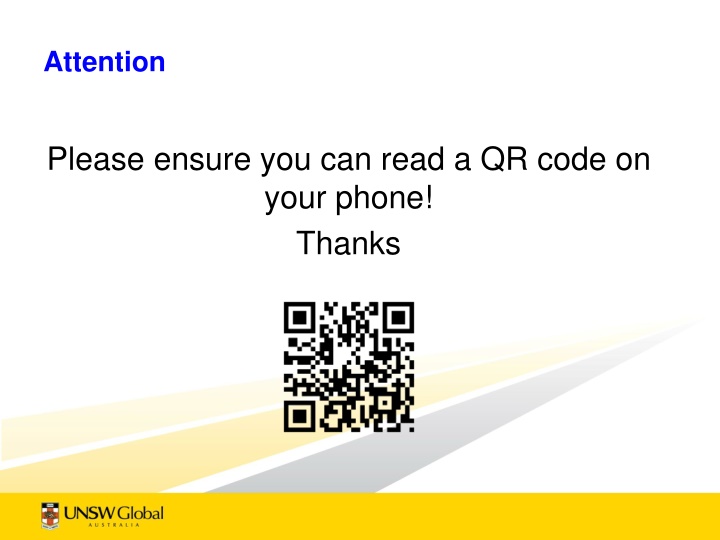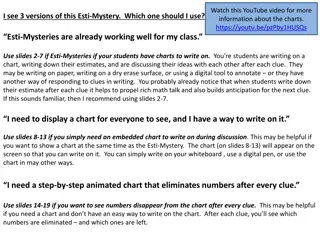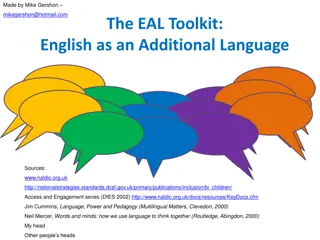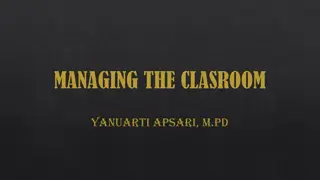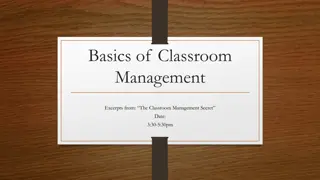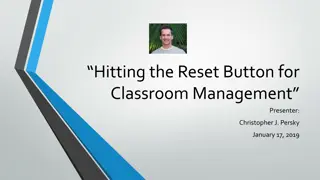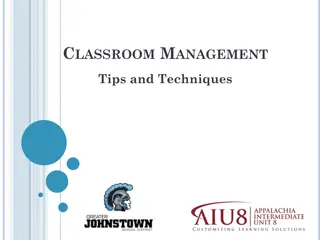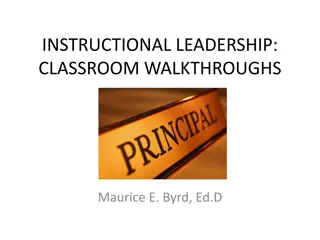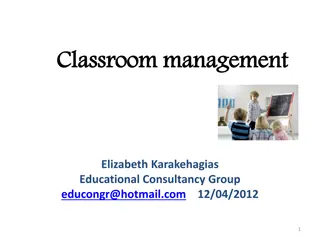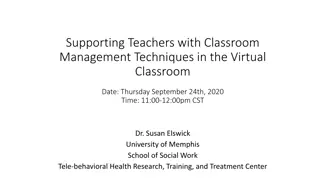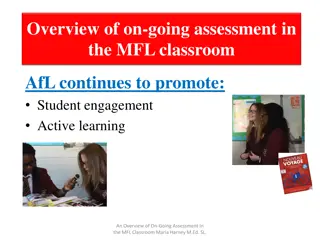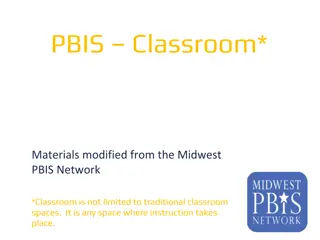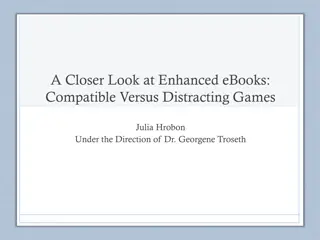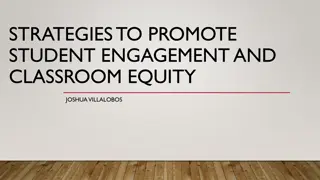Energisers for Enhanced Classroom Engagement
Energisers are brief activities designed to boost energy and engagement in groups. They can involve physical movement, laughter, or cognitive challenges, enhancing cognition and on-task behavior. These activities are valid for learning as they stimulate learning tools like perception, memory, and attention, increase blood flow to the brain, and create novel situations that activate the brain's systems. Utilizing energisers in classrooms has shown improvements in on-task behavior and reduced off-task behaviors. Incorporating both physical and language-based energisers can create a dynamic learning environment that fosters better cognition and mood regulation.
Download Presentation

Please find below an Image/Link to download the presentation.
The content on the website is provided AS IS for your information and personal use only. It may not be sold, licensed, or shared on other websites without obtaining consent from the author.If you encounter any issues during the download, it is possible that the publisher has removed the file from their server.
You are allowed to download the files provided on this website for personal or commercial use, subject to the condition that they are used lawfully. All files are the property of their respective owners.
The content on the website is provided AS IS for your information and personal use only. It may not be sold, licensed, or shared on other websites without obtaining consent from the author.
E N D
Presentation Transcript
Attention Please ensure you can read a QR code on your phone! Thanks
Innovate and Invigorate! Physical Energisers for the EAP Classroom. By Brooke Naylor and Colleen Bray UECA April 2019
What is an energiser? An energiser is a brief activity that is intended to increase energy in a group by engaging the participants in physical activity, laughter, or in ways that engage the members cognitively (problem-solving). An energiser can be used with any group, including during training http://thetrainingworld.com/resources/Training_Methods_and_Activities/ energisers/
Language-based versus physical energiser Language-based energiser: purpose to develop language Physical energiser: purpose to move the body and create energy rather than develop language
Are physical energisers valid? Is it valid to do an activity where the primary goal is not language improvement? YES! Because it enhances learning.
Energisers enhance cognition Stimulate tools of learning: perception, memory, attention, concentration etc (Dodd 2015) Increase circulation in the body Increase flow of blood, oxygen and glucose to brain: the brain s fuel Increase blood flow by 5-8% compared to sitting and higher flows for movement (Almarode & Almarode 2008)
Energisers enhance cognition Create a novel unexpected situation which activates reticular activation system ( RAS) in brain If the RAS is more active, more likely to filter our irrelevant info and helps students focus (Almarode & Almarode 2008) Exercise and movement strongly correlated with physical changes in the brain: increases in brain mass, and cell growth, leading to better cognition and mood regulation (Jensen 2000)
Energisers enhance on-task behaviour Recent studies found that 5-10 mins of energising activity in school classrooms improves on-task behaviours and reduces off-task behaviours such as unnecessary movement, talking and inattention. (Mahar et al 2006; Mahar 2011; Mulrine, Prater, Jenkins 2008; Carlson et al 2015; Howie, Beets & Pate 2014; Erwin et al 2012) Anecdotal evidence of this for ESL learners and adults (Chlup & Collins 2012; Arechiga 2012)
Energisers provide a break from learning Human attention span is 15 minutes before needing a break Brain designed to learn in short bursts followed by time to process info. We need time for memory function and settling Eg hippocampus is area of brain which organises, sorts and processes incoming information before routing to various areas of cortex for long term memory. If we overload this structure, it results in no new learning ( Jensen 2005)
Energisers can stimulate release of bodys feel good chemicals Noradrenalin released with excitement/novelty Also helps with fixing of memories (Jensen 2000; Almarode & Almarode 2008) Dopamine released through positive social bonding and gross repetitive movements Dopamine also enhances attention (Jensen 2000; Almarode & Almarode 2008 Laughter stimulates release of endorphins, oxytocin ( cuddle hormone) and activates parasympathetic nervous system which calms body down (Ovnas-Moberg 1989; Dodd 2015)
Energisers are an antidote to too much sitting Body not designed for sitting on chairs Negative risks to health poor breathing, compressed organs, strained spinal column and lower back nerves, overall fatigue Eg, pressure on spinal disks increases by 30% when sitting compared to standing (Jensen 2000)
How to implement energisers Don t explain why students need to do an energiser - they are tired of listening to us and are likely to resist if you explain too much. Just get them to do it! (You can provide the rationale later if they question the relevance of the activity) Not explaining will also will add to the novelty, fun and stimulation of the activity which is more stimulating for the body and brain
How to implement energisers Best to do when students are fatigued, inattentive or to break up long tasks/presentations It can be an active energiser or a calming one, depending on need Add to your tool bag Be aware of cultural issues regarding touch
Energisers - activity 1. You will be divided into 4 groups. Each group will have a different energiser. 2. Each group will be given a different QR code that links to a short video demonstrating one energiser. We will also provide written instructions. 3. Watch the video closely and/or read the instructions. Discuss with your group how to run the energizer.
Energisers - activity 4. Choose 1-2 people from your group who will give instructions to the other three groups ( as one big group) to do the energiser. 5. The remaining group members can go around helping the plenary to understand the activity or can join the activity.
Energisers Any questions or comments?
Reference list Arechiga, D., 2013. Reaching English language learners in every classroom: Energizers for teaching and learning. Routledge. Almarode, J. and Almarode, D., 2008. Energizing students. The Science Teacher, 75(9), p.32. Carlson, J.A., Engelberg, J.K., Cain, K.L., Conway, T.L., Mignano, A.M., Bonilla, E.A., Geremia, C. and Sallis, J.F., 2015. Implementing classroom physical activity breaks: Associations with student physical activity and classroom behavior. Preventive medicine, 81, pp.67-72. Chlup, D.T. and Collins, T.E., 2010. Breaking the ice: using ice- breakers and Re-energizers with adult learners. Adult Learning, 21(3-4), pp.34-39.
Reference list Dodd, G.D., 2015. The unrealised value of human motion moving back to movement! . Asia-Pacific Journal of Health, Sport and Physical Education, 6(2), pp.191-213. Erwin, H., Fedewa, A., Beighle, A. and Ahn, S., 2012. A quantitative review of physical activity, health, and learning outcomes associated with classroom-based physical activity interventions. Journal of Applied School Psychology, 28(1), pp.14-36. Howie, E.K., Schatz, J. and Pate, R.R., 2015. Acute effects of classroom exercise breaks on executive function and math performance: A dose response study. Research Quarterly for Exercise and Sport, 86(3), pp.217-224.
Reference list Jensen, E., 2000. Moving with the brain in mind. Educational leadership, 58(3), pp.34-38. Jensen, E., 2005. Teaching with the brain in mind. ASCD. Mahar, M.T., Murphy, S.K., Rowe, D.A., Golden, J., Shields, A.T. and Raedeke, T.D., 2006. Effects of a classroom-based program on physical activity and on-task behavior. Medicine and science in sports and exercise, 38(12), p.2086. Mahar, M.T., 2011. Impact of short bouts of physical activity on attention-to-task in elementary school children. Preventive medicine, 52, pp.S60-S64.
Reference list Maley, A. and Duff, A., 2006. Drama techniques: A resource book of communication activities for language teachers. Ernst Klett Sprachen. Mulrine, C.F., Prater, M.A. and Jenkins, A., 2008. The active classroom: Supporting students with attention deficit hyperactivity disorder through exercise. Teaching exceptional children, 40(5), pp.16-22. Uvn s-Moberg, K., 1998. Oxytocin may mediate the benefits of positive social interaction and emotions. Psychoneuroendocrinology, 23(8), pp.819-835.
